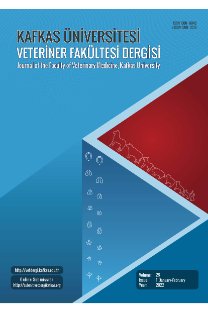A Case of Trichophyton mentagrophytes Infection in RabbitsAccompanied by Farm Staff Infection in China
Çin'de Çiftlik Çalışanları ile Birlikte Tavşanlarda Trichophyton mentagrophytes Enfeksiyonu Olgusu
___
- Weitzman I, Summerbell RC: The dermatophytes. Clin Microbiol Rev, , 240-259, 1995.
- Degreef H: Clinical forms of dermatophytosis (ringworm infection). Mycopathologia, 166, 257-265, 2008. DOI: 10.1007/s11046-008-9101-8
- Torres-Rodríguez JM, Dronda MA, Rossell J, Madrenys N: Incidence of dermatophytoses in rabbit farms in Catalonia, Spain, and its repercussion on human health. Eur J Epidemiol, 8, 326-329, 1992. DOI: 10.1007/ BF00158563
- Proverbio D, Perego R, Spada E, Bagnagatti de Giorgi G, Della Pepa A, Ferro E: Survey of dermatophytes in stray cats with and without skin lesions in Northern Italy. Vet Med Int, 2014. DOI: 10.1155/2014/565470
- Cafarchia C, Camarda A, Coccioli C, Figueredo LA, Circella E, Danesi P, Capelli G, Otranto D: Epidemiology and risk factors for dermatophytoses in rabbit farms. Med Mycol, 48, 975-980, 2010. DOI: 3109/13693781003652620
- Bond R: SuperŞcial veterinary mycoses. Clin Dermatol, 28, 226-236, DOI: 10.1016/j.clindermatol.2009.12.012
- Cafarchia C, Weigl S, Figueredo LA, Otranto D: Molecular identification and phylogenesis of dermatophytes isolated from rabbit farms and rabbit farm workers. Vet Microbiol, 154, 395-402, 2012. DOI: 10.1016/j. vetmic.2011.07.021
- Gross TL, Walder EJ, Ihrke PJ: Feline and Canine Dermatophytosis. In, Veterinary Dermatopathology: A Macroscopic and Microscopic Evaluation of Canine and Feline Skin Disease. 243-245, Mosby, St Louis, 1992.
- Yager JA, Wilcox BP: Dermatophytosis. In, Color Atlas and Text of Surgical Pathology of the Dog and Cat. 188-189, Mosby, St Louis, 1994.
- Fairley RA: The histological lesions of Trichophyton mentagrophytes var erinacei infection in dogs. Vet Dermatol, 12, 119-122, 2001. DOI: 1046/j.1365-3164.2001.00235.x
- ISSN: 1300-6045
- Yayın Aralığı: 6
- Başlangıç: 1995
- Yayıncı: Kafkas Üniv. Veteriner Fak.
Biomechanical Parameters of Asian Elephant (Elephas maximus)Walking Gait
Siriphan KONGSAWASDI, Sittidej MAHASAWANGKUL, Pornsawan PONGSOPAWIJIT, Kajornphat BOONPRASERT, Busaba CHUATRAKOON, Nipaporn THONGLORM, Rungtiwa KANTA-IN, Tanapong TAJARERNMUANG, Korakot NGANVONGPANIT
Hamid Reza SEYEDABADI, Sima SAVAR SOFLA
Surgical Treatment of Dorsal Scapular Luxation in Cats: Six Cases (2010-2016)
KÜRŞAT ÖZER, MURAT KARABAĞLI, Haluk ÖMER, Muhammet Eyüp DEMİR
Asghar GHAHREMANI, Ali Asghar SADEGHI, Saeed HESARAKI, Mohammad CHAMANI, Parvin SHAWRANG
RECEP GÜMÜŞ, H. Serkan EROL, HALİT İMİK, MESUT BÜNYAMİ HALICI
Xiancheng ZENG, Qingli ZHENG, Xuelin CHI
Huan ZHANG, Liping GUO, Qingqing WEI, Ke ZHANG, Shanahan ZHAO, Hongyu LI, Chuangfu CHEN, Wanjiang ZHANG, Yali ZHANG, Yuanzhi WANG
Hacı Ahmet DEVECİ, ABDULSAMED KÜKÜRT, ERDOĞAN UZLU, İBRAHİM SÖZDUTMAZ, OĞUZ MERHAN, MUSTAFA SİNAN AKTAŞ, MERVE ALPAY, İNAN KAYA, MAHMUT KARAPEHLİVAN
Hongyun ZHU, Hui ZHANG, Yajing WANG, Danba CIREN, Hailong DONG, Qingxia WU, Mujeeb Ur REHMAN, Fazul NABI, Khalid MEHMOOD, Jingen XU, Jiakui LI
Gene Primer SEQUENCE, H. Kaan MÜŞTAK, Kaan ÖNAT, K. Serdar DIKER
